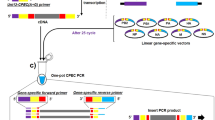Abstract
The reverse genetics system for influenza A viruses described by Hoffmann et al. (Virology 267(2):310–317, 2000, Proc Natl Acad Sci USA 97(11):6108–6113, 2000, ArchVirol 146(12):2275–2289, 2001) is one of the most commonly used. However, this cloning strategy is rather time-consuming and lacks a selection marker to identify positive clones carrying viral genes. We report here the optimization of the cloning protocol of viral genes into pHW2000 by (i) introducing a selection marker and (ii) simplifying the cloning strategy: now the cloning reaction takes only a few minutes and, in addition, is independent of internal restriction sites for BsmBI/Esp3I, BsaI or AarI. In order to accelerate the whole cloning protocol for the generation of recombinant viruses, we first introduced a lacP/Z-element (lac-promoter/lacZα-fragment) between the two BsmBI sites of pHW2000 to allow selection of positive clones by blue/white screening. Then we optimized the digestion/ligation-protocol: In our system, enzymatic digestion and ligation of PCR products into the vector is performed in a single “one-tube” reaction. Due to this strategy, time and material consumption is reduced by a great amount, as vector and cDNA do not have to be digested and purified prior to the ligation. Therefore, this one-tube reaction yields positive clones with high efficiency and fidelity, again saving time and material, which were formerly required for screening and analyzing clones. Finally, to add more versatility to the system, we also created an entry vector based on TA-cloning. This entry vector provides several advantages: inserted genes can easily be modified, e.g., by site-directed mutagenesis or tag attachment, and then subcloned into pHW2000 or other plasmids containing a similar cloning site (e.g., our modified pCAGGS-Esp-blue) by the same rapid and reliable one-tube reaction protocol described here. In fact, the presented protocol is suitable to be adapted to other reverse genetics systems (e.g., those for members of the order Mononegavirales or the family Bunyaviridae) or cloning of genes in general.




Similar content being viewed by others
References
Hoffmann E et al (2000) “Ambisense” approach for the generation of influenza A virus: vRNA and mRNA synthesis from one template. Virology 267(2):310–317
Hoffmann E et al (2000) A DNA transfection system for generation of influenza A virus from eight plasmids. Proc Natl Acad Sci USA 97(11):6108–6113
Hoffmann E et al (2001) Universal primer set for the full-length amplification of all influenza A viruses. Arch Virol 146(12):2275–2289
Neumann G et al (1999) Generation of influenza A viruses entirely from cloned cDNAs. Proc Natl Acad Sci USA 96(16):9345–9350
Fodor E et al (1999) Rescue of influenza A virus from recombinant DNA. J Virol 73(11):9679–9682
de Wit E et al (2007) A reverse-genetics system for Influenza A virus using T7 RNA polymerase. J Gen Virol 88(Pt 4):1281–1287
Zobel A, Neumann G, Hobom G (1993) RNA polymerase I catalysed transcription of insert viral cDNA. Nucleic Acids Res 21(16):3607–3614
Selmer T, Pinkenburg O (2008) WO2008095927 (A1) Method of cloning at least one nucleic acid molecule of interest using type IIs restriction endonucleases, and corresponding cloning vectors, kits and system using type IIs restriction endonucleases. Patent Assignee: Philipps-University Marburg; Inventors: Selmer T, Pinkenburg O
Engler C, Kandzia R, Marillonnet S (2008) A one pot, one step, precision cloning method with high throughput capability. PLoS One 3(11):e3647
Niwa H, Yamamura K, Miyazaki J (1991) Efficient selection for high-expression transfectants with a novel eukaryotic vector. Gene 108(2):193–199
Holton TA, Graham MW (1991) A simple and efficient method for direct cloning of PCR products using ddT-tailed vectors. Nucleic Acids Res 19(5):1156
Inoue H, Nojima H, Okayama H (1990) High efficiency transformation of Escherichia coli with plasmids. Gene 96(1):23–28
Zhou MY, Gomez-Sanchez CE (2000) Universal TA cloning. Curr Issues Mol Biol 2(1):1–7
Stech J et al (2008) Rapid and reliable universal cloning of influenza A virus genes by target-primed plasmid amplification. Nucleic Acids Res 36(21):e139
Wang S et al (2008) Simplified recombinational approach for influenza A virus reverse genetics. J Virol Methods 151(1):74–78
Zhou B et al (2009) Single-reaction genomic amplification accelerates sequencing and vaccine production for classical and Swine origin human influenza a viruses. J Virol 83(19):10309–10313
Geng L et al (2006) A universal cloning vector using vaccinia topoisomerase I. Mol Biotechnol 33(1):23–28
Acknowledgments
We thank Folker Schwalm for providing primers for the PA, HA and PB2 segments, Erich Hoffmann and Robert G. Webster for the pHW2000 plasmid, and J. Miyazaki for the pCAGGS plasmid. This work was supported by the FluResearchNet, funded by the Federal Ministry of Education and Research.
Conflict of interest
The authors have declared that no conflict of interest exists.
Author information
Authors and Affiliations
Corresponding authors
Rights and permissions
About this article
Cite this article
Czudai-Matwich, V., Schnare, M. & Pinkenburg, O. A simple and fast system for cloning influenza A virus gene segments into pHW2000- and pCAGGS-based vectors. Arch Virol 158, 2049–2058 (2013). https://doi.org/10.1007/s00705-013-1697-4
Received:
Accepted:
Published:
Issue Date:
DOI: https://doi.org/10.1007/s00705-013-1697-4




